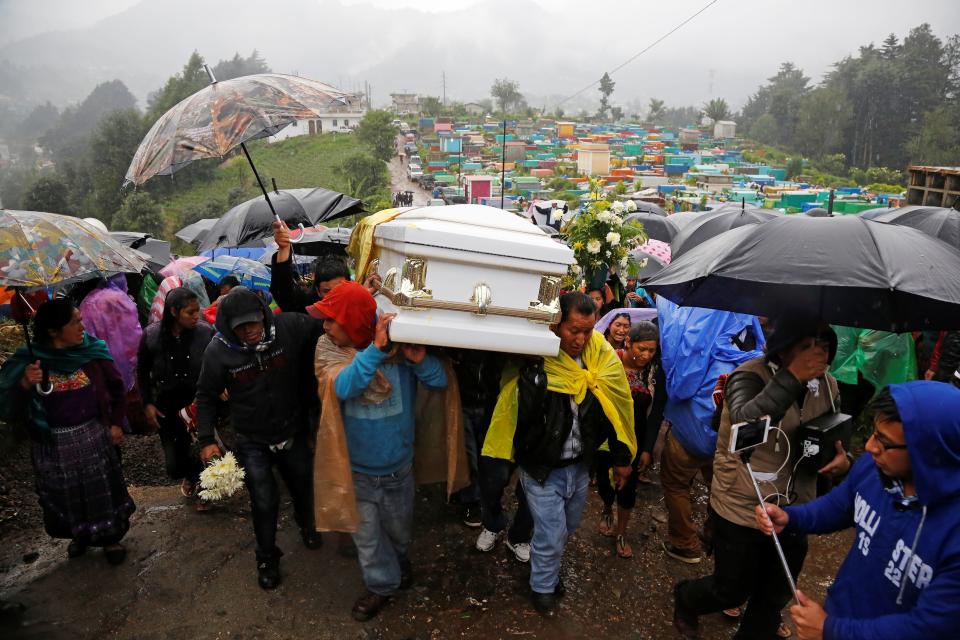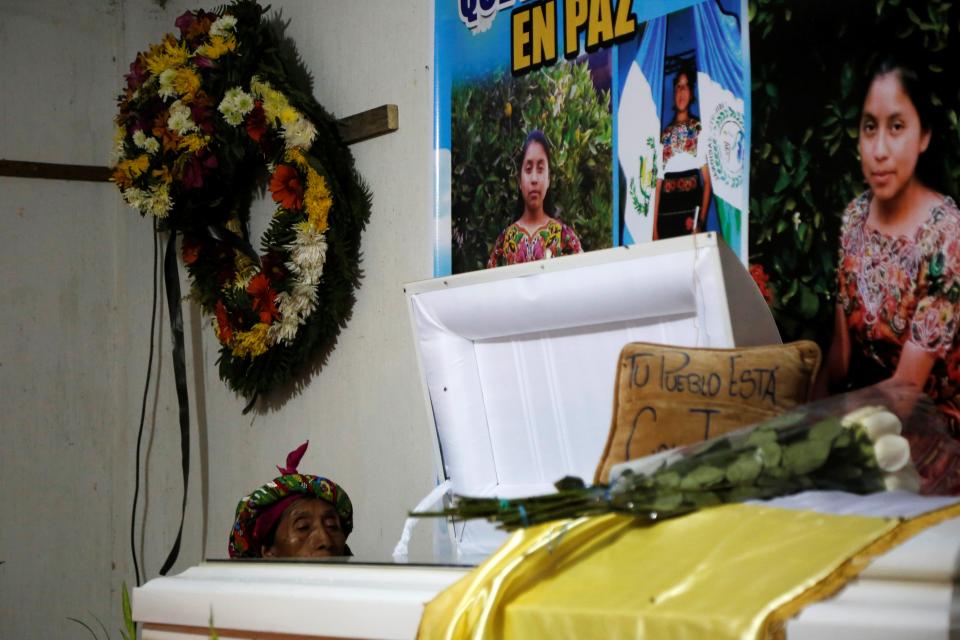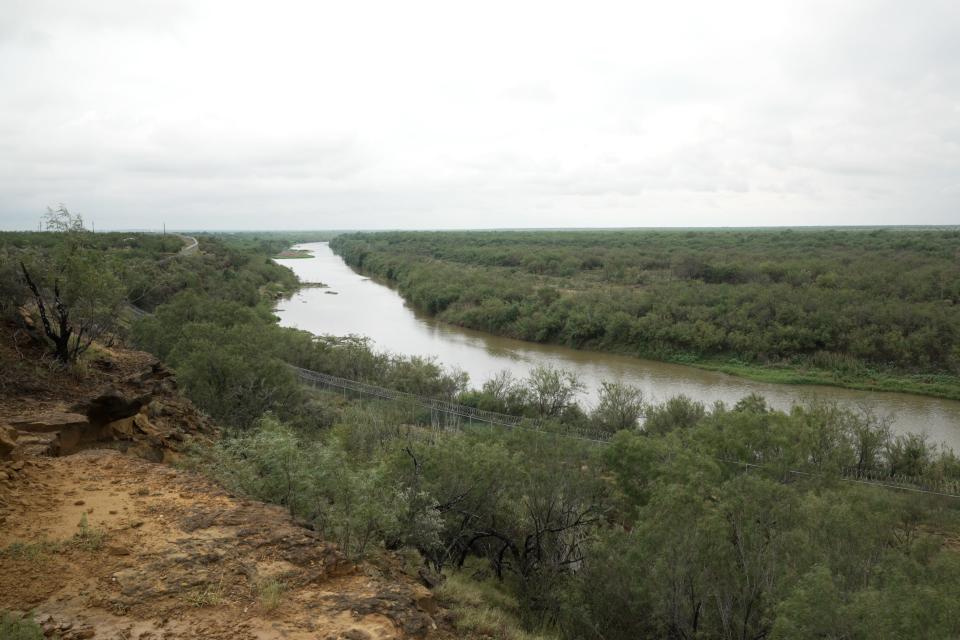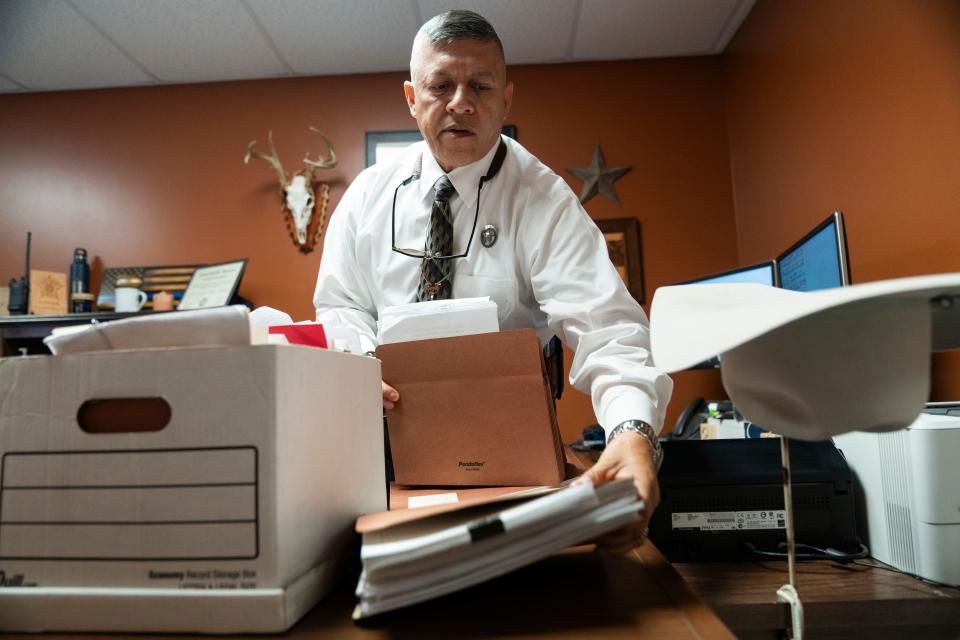3 days of silence: Records reveal inside story of Border Patrol shooting
RIO BRAVO, Texas – When Claudia Patricia Gómez González and five other migrants floated across the Rio Grande on a bright spring morning, Border Patrol agents detected them almost immediately.
One agent started tracking their footprints through Rio Bravo, a tiny suburb 14 miles downstream from Laredo. Two others, mounted on ATVs, rolled through the adjacent blocks.
A few minutes later, Gómez was lying in the tall grass of an empty lot on Centeno Lane, blood streaming from a bullet wound in the back of her head.
As she took her last breaths, the abandoned lot started to fill up.
Troopers from the state Department of Public Safety would arrive, some with guns drawn. A county sheriff’s deputy, wearing a body camera, would take in the whole scene in minute detail, right down to the black gloves one Border Patrol agent had been wearing.
There would be a Texas Ranger, FBI agents, even a woman from the neighborhood who emerged from her house to stream video of the scene to her Facebook page. Soon, a team of paramedics would arrive to try to save Gómez’s life. By then, one person wasn’t there: Romualdo Barrera, the U.S. Border Patrol agent who had fired the shot that penetrated Gómez’s skull.
Investigators would not speak to Barrera at the scene, or nearby. They wouldn’t interview him for another three days.

News of the shooting of Claudia Gómez came and went quickly in spring 2018 amid the sea of headlines about then-president Donald Trump’s controversial border policies. Since then, a surge of crossings has only increased the larger debate over border security.
But inside the nation’s intractable immigration battle, advocates and researchers say, sits one remarkable consistency: When Border Patrol agents shoot and kill migrants, they are almost never punished.
In the Border Patrol’s 100-year history, no agent has ever been convicted of a wrongful killing while on duty.
Since 2010, according to the advocacy group Southern Border Communities Coalition, which tracks all such cases, there have been 304 fatal encounters with agents from the Border Patrol and its parent entity, Customs and Border Protection. Those deaths include 68 “use of force” killings, such as fatal shootings, asphyxiations and Taser shots, as well as 108 deaths caused by vehicle collisions, the majority of which occurred during high-speed chases initiated by the Border Patrol, according to the group’s statistics.
For years, critics claimed investigative teams deployed to shooting scenes actually worked to conceal evidence and protect agents. The agency announced in 2022 that it had disbanded those so-called Critical Incident Teams, but a recent federal investigation found the agency still struggles to investigate its own shootings properly.
In the 2018 shooting of Claudia Gómez, there was no rush to transparency.

Barrera was never charged, so there is no criminal filing. Gómez's family settled a lawsuit against the federal government for an undisclosed amount – and on the condition that the family agree not to discuss the case – so there is no civil court record. The FBI would tell investigators it found no civil rights violations. A CBP official said the shooting remains under investigation now, six years later, so there are no internal findings to review.
But the Border Patrol wasn’t the only agency to arrive in the empty lot that morning.
Documents obtained by USA TODAY, including investigative reports by the Texas Department of Public Safety and Webb County Sheriff’s Office, offer a rare glimpse into what happens after an agent pulls the trigger.
As authorities gathered, paramedics tested Gómez with an electrocardiogram, then stretched a silver thermal blanket over her body. By then, the Rangers' report shows, Barrera was already on the move.
First he sat on a stump a few blocks away, where he handed over the gun from the shooting, trading it to a colleague who stashed it under the seat of a patrol vehicle. Border Patrol officials later explained to investigators what happened next.
One drove Barrera to the Exxon station at the edge of Rio Bravo. As they waited in the gas station parking lot at the foot of the highway, a white BMW rolled in off the road. Inside were an attorney for the Border Patrol agents’ union and two other passengers – the other two agents who had been on patrol during the shooting.
The group conferred in the parking lot. Then, with Barrera in one vehicle and his two fellow agents in the other, they pulled onto the highway and headed out of town.
Special report: In hunt for cartel hitmen, Texas Ranger's biggest obstacle may be the border itself
Barrera’s interview
Three days later, the investigators’ notes show, Barrera walked into the FBI office in Laredo flanked by the attorney from the car, George Altgelt, and another attorney, Oscar Osmar Pe?a.
Sitting at a table across from an FBI investigator and the Texas Ranger, Barrera retold the events of the shooting as he remembered it.
It was a sensor that first detected the group’s footfalls that morning in late May 2018 as six migrants crossed through the town.
Barrera and the other agents on duty had already been on alert that day after one of them reported seeing a man with a tattoo on his neck. The border agents thought the man was a scout for a smuggling operation.
It wouldn’t be the first time they had caught smugglers in Rio Bravo. The city’s arrow-straight streets climb from the riverbank toward the U.S. highway at the edge of town, and from there, the rest of the country.
Barrera knew how to track footprints through the brush. He set his sights on a possible hiding spot on Centeno Lane and gunned the motor of his Border Patrol ATV.
As Barrera approached the empty lot, someone else approached him first. It was the man with a tattoo on his neck. The sight left Barrera on high alert.
Barrera followed the footprints into the brush of the empty lot and saw the migrants for the first time. There were six of them, huddled in the corner of the lot.
One of the migrants was holding a stick the size of a broom handle, he remembered. In that moment, Barrera was alone and outnumbered.
“?Agachense! Get down!" he yelled in Spanish and English.
He pulled his .40-caliber service pistol from its holster and held it ready. Instead of complying, the group of migrants rushed toward him, he told investigators. He reenacted the scene as investigators watched.
Two of the migrants shoved his right arm straight out to the side, the gun now pointing wide. He tried to fend off two others with his left arm. As he struggled, Barrera said, he could feel another person slip beneath his right arm. He could feel a pair of hands sliding closer to the gun that was still in his grasp.
He feared he was losing the weapon. He squeezed harder. The gun fired.
"I tried to hold on to my gun. ... I squeezed it, and the round went off,” Barrera told investigators.
As Barrera relived the scene, the investigators noticed he grew visibly shaken.
At the empty lot, he fell to the right, he said, dropped to his knees, and braced himself with his gun hand on the ground.
Pe?a, the attorney, interrupted to note that Barrera did not have “independent memory” of pulling the trigger.
But Barrera did describe the next thing he remembered seeing: a woman, unresponsive, lying on the ground, with a hoodie covering her head.
The life and death of Claudia Gómez
Claudia Gómez grew up in the outskirts of Quetzaltenango in Guatemala, in a small, poverty-choked village. Most of the people are Indigenous. She graduated high school with high marks and dreamed of becoming an accountant. But with no money for college and unable to find a job, hope faded.
In May 2018, when she was 20, Gómez left for the United States. She trekked across Mexico and arrived at a safe house in Nuevo Laredo at around 7 p.m. on May 22. Other migrants were there already, including at least one from her hometown in Guatemala.

The next morning, on May 23, Gómez and the other migrants floated across the Rio Grande on inner tubes, according to the Texas Department of Public Safety report’s account of their interviews. The asylum-seekers followed directions through the blocks of Rio Bravo to a wooded area with tall grass, next to a white house. There, they were told, they should wait for a pickup.
The grassy hiding spot was the empty lot on Centeno Lane. Before their pickup arrived, Barrera found them. Moments later, Gomez was on the ground, bleeding.
The news of Gómez’s death would shock people up and down the continent.
In Guatemala, her home country, the ministry of foreign affairs would call for a thorough investigation. Border advocates did the same. In the weeks that followed, her parents would demand justice for their slain daughter. Her body was returned to her hometown, and hundreds of mourners flocked there to pay respects to Gómez during a funeral that drew international media attention.
But in the first moments after the shooting, perhaps no one was more stunned than Marta Martinez.
Her house sits next door to the empty lot. She was inside that day when she heard the gunshot. She emerged to find someone running across her front yard.
Martinez would later say that she expected to find someone had shot up into the air. She weaved through the cars parked out front and into the brush of the lot next door. Her cellphone in hand, Martinez started streaming the scene to Facebook Live.
Once the controversy about her video blew up, she removed it from the internet. Today, Martinez declines to talk about what she saw. But news reports from the time detail how shocked she was when she saw Gómez in the brush of the empty lot.
Why did you shoot the girl? she shouted as the livestream rolled. You killed her!
Special report: VIP package for migrants trying to get into US
The migrants’ version of events
That question was much like the ones investigators would put to the men who were caught in the empty lot.
Hours after the shooting, Carlos Perez-Vicente, also a native of Quetzaltenango, Guatemala, would face FBI and Texas Rangers investigators in Laredo.
He said he was with five other migrants, including Gómez, when Barrera approached them in the empty lot. A few of the migrants fled at the sight of the border agent, but Perez-Vicente said he and Gómez stayed, crouching in the tall grass.
He told investigators that Gómez then “attempted to run away towards the street when she was shot and that she was near the fence.”
An investigator asked Perez-Vicente if anyone in the group was armed or if anyone in the group tried to assault the Border Patrol agent. No, he said.
Another asylum-seeker on the scene, Damian Mendez-Penalonso, also from Guatemala, described to investigators how Barrera approached them in the empty lot, walking slowly at first, then picking up his pace and drawing his gun as he spotted them crouched in the grass. Mendez-Penalonso said no one rushed the agent and no one had any weapons or sticks.
He said Gómez tried to flee over a fence when she was shot. He heard her let out a final, short scream as she dropped to the ground, bleeding.
As they spoke to the migrants at the FBI office, investigators would walk out of the interrogation room, consult their notes, then reenter and meticulously ask them specific questions again, such as their position relative to Barrera and whether any weapons were wielded at the agent. The witnesses stuck to their story.
The migrants also were interviewed by Border Patrol attorneys over several days.
According to the FBI agent, “defense attorneys cross-examined three material witnesses for three days, and they never wavered from their initial testimony,” the report read. “Their statements differed from Agent Barrera’s account of events.”
A Webb County Medical Examiner’s report would later say the bullet entered the back of Gómez’s head, traveled right to left and up, and exited the front, “causing severe injury to the brain,” aligning with Perez-Vicente’s account. The death was ruled a homicide.
The aftermath
Some of what happened between Gómez’s shooting and Barrera’s first interview, three days later, can be pieced together through statements in the investigative records.
Bodycam video pulled from Webb County Sheriff’s deputies who responded to the shooting showed Barrera wearing black gloves at the scene, the kind of gloves another agent said were typically assigned to those patrolling on ATVs.
As investigators at the scene began to interview witnesses, Sergio Buriano, a Laredo representative for the Border Patrol union, arrived and drove Barrera to a spot a few blocks away. Border Patrol Assistant Chief Manuel Crispin Martinez soon arrived.
“Are you good?” he asked Barrera. The agent nodded.
Martinez took Barrera’s .40-caliber handgun and put it in his holster, according to Buriano’s later interviews with the investigators. In exchange, he handed Barrera his own service weapon. The two men hugged. Martinez then gave Barrera’s weapon to another agent, who shoved it under the seat of his Chevy Tahoe.
That agent drove Barrera 2 miles east to the Exxon gas station on U.S. Highway 83. Buriano, the union rep, drove up, as did Altgelt, the Border Patrol attorney.
They talked about what to do with Barrera and ultimately agreed to drive him farther away, to a Border Patrol station nearer to Laredo. Later, an agent said he moved Barrera’s weapon from under the seat of the Chevy to the console and brought it into the Border Patrol station.
Though it’s sometimes common to remove a firearm from the scene of an officer-involved shooting, it’s less normal for officers to leave before speaking with independent investigators, said Gil Kerlikowske, CBP commissioner from 2014 to 2017, who pushed for more transparency and better policing tactics at the agency.
“It’s really helpful if they stay at the scene,” Kerlikowske said. “Certain things can come up or there could be a question for the officer. … You don’t want them so far away you’re missing something.”
The flood of agents – who surrounded Barrera, directed him away from questions and took over evidence such as his gun – is a well-worn story for migrant advocates, who spent years criticizing the Border Patrol's Critical Incident Teams.
“This is standard operating procedure for border agents wanting to interfere with an investigation,” said Andrea Guerrero, executive director of Alliance San Diego, an advocacy group that has represented asylum-seekers in officer-involved shootings. “We’ve seen it happening across dozens, perhaps hundreds of cases over the years.”
In 2022, former CBP Commissioner Chris Magnus terminated the Critical Incident Teams, but a year later, Guerrero and other advocates wrote a letter to Congress, alleging that the practice continues.
A U.S. Government Accountability Office report released last month studied how Customs and Border Protection and its investigative arm, the Office of Professional Responsibility (OPR), respond to incidents, including shootings. They found the agency still struggles to conduct independent, thorough investigations involving its agents.
“OPR has made significant progress implementing investigative standards ? which it adopted in 2020 ? but it could strengthen its efforts regarding investigator independence,” the report said.
Katherine Hawkins of the Project on Government Oversight, a nonpartisan independent watchdog group that was also critical of the teams, reaches a similar conclusion.
“There is some progress,” she said, “but it’s unclear how far it’s taken us.”
The National Border Patrol Council, a representative of the Laredo chapter of the union and Altgelt, the attorney representing Barrera, didn’t respond to several requests for comment for this story.

Texas Ranger E.J. Salinas, who took over the Gómez investigation three months after the shooting, said Border Patrol union members, along with peer support teams and union attorneys, often arrive at the scene of agent-involved crimes before investigators do, and the agent will often leave the scene.
Aside from questions about the agents’ own culpability, the entire investigation becomes more difficult if the agent involved leaves the scene, he said. Collecting evidence is harder if the agent isn’t there to point out where it may be.
As the investigation unspooled, advocate groups sued the federal government over the shooting. The American Civil Liberties Union filed a lawsuit on behalf of Gómez’s family. Last year, the group settled with the government for an undisclosed amount.
The Webb County District Attorney’s Office declined to bring criminal charges against Barrera because, in part, Gómez’s family was suing the federal government in a federal civil case. In an email dated Jan. 6, 2022, Assistant District Attorney Amber Holmes wrote to the Border Patrol Laredo Sector, stating she did not intend to file charges partly because federal prosecutors felt they could not prove “willful intent,” but also because the federal government was now defending Barrera in the civil suit.
“The (federal government) has already stated that they support Barrera's actions and he committed no crime,” she wrote.
A spokeswoman for the district attorney’s office said they couldn’t comment on the case because it’s still being investigated by CBP.
A CBP spokeswoman wouldn’t comment on the Gómez case, citing the ongoing investigation.
As for the Texas Rangers’ investigation, it documents periodic inquiries until early 2019, when the work was submitted to prosecutors.
It notes that after Barrera’s .40-caliber pistol was transferred from person to person for hours after the shooting, it was finally submitted to an FBI laboratory for testing. The lab later concluded the distance from the pistol barrel to the wound on Gómez’s head was less than 12 inches.
But the black gloves Barrera was seen wearing at the shooting scene were never found.
Five days after the shooting, he was back at work.
Rick Jervis is a national correspondent for USA TODAY based in Austin, Texas. Follow him on X @MrRJervis or contact him at: [email protected].
This article originally appeared on USA TODAY: Dark details emerge in probe of controversial Border Patrol shooting